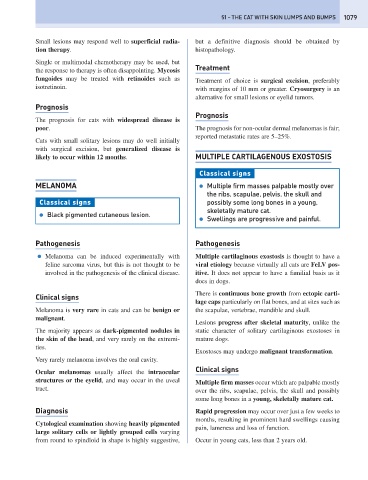Page 1087 - Problem-Based Feline Medicine
P. 1087
51 – THE CAT WITH SKIN LUMPS AND BUMPS 1079
Small lesions may respond well to superficial radia- but a definitive diagnosis should be obtained by
tion therapy. histopathology.
Single or multimodal chemotherapy may be used, but
Treatment
the response to therapy is often disappointing. Mycosis
fungoides may be treated with retinoides such as Treatment of choice is surgical excision, preferably
isotretinoin. with margins of 10 mm or greater. Cryosurgery is an
alternative for small lesions or eyelid tumors.
Prognosis
Prognosis
The prognosis for cats with widespread disease is
poor. The prognosis for non-ocular dermal melanomas is fair;
reported metastatic rates are 5–25%.
Cats with small solitary lesions may do well initially
with surgical excision, but generalized disease is
likely to occur within 12 months. MULTIPLE CARTILAGENOUS EXOSTOSIS
Classical signs
MELANOMA ● Multiple firm masses palpable mostly over
the ribs, scapulae, pelvis, the skull and
Classical signs possibly some long bones in a young,
skeletally mature cat.
● Black pigmented cutaneous lesion.
● Swellings are progressive and painful.
Pathogenesis Pathogenesis
● Melanoma can be induced experimentally with Multiple cartilaginous exostosis is thought to have a
feline sarcoma virus, but this is not thought to be viral etiology because virtually all cats are FeLV pos-
involved in the pathogenesis of the clinical disease. itive. It does not appear to have a familial basis as it
does in dogs.
There is continuous bone growth from ectopic carti-
Clinical signs
lage caps particularly on flat bones, and at sites such as
Melanoma is very rare in cats and can be benign or the scapulae, vertebrae, mandible and skull.
malignant.
Lesions progress after skeletal maturity, unlike the
The majority appears as dark-pigmented nodules in static character of solitary cartilaginous exostoses in
the skin of the head, and very rarely on the extremi- mature dogs.
ties.
Exostoses may undergo malignant transformation.
Very rarely melanoma involves the oral cavity.
Clinical signs
Ocular melanomas usually affect the intraocular
structures or the eyelid, and may occur in the uveal Multiple firm masses occur which are palpable mostly
tract. over the ribs, scapulae, pelvis, the skull and possibly
some long bones in a young, skeletally mature cat.
Diagnosis Rapid progression may occur over just a few weeks to
months, resulting in prominent hard swellings causing
Cytological examination showing heavily pigmented
pain, lameness and loss of function.
large solitary cells or lightly grouped cells varying
from round to spindloid in shape is highly suggestive, Occur in young cats, less than 2 years old.

